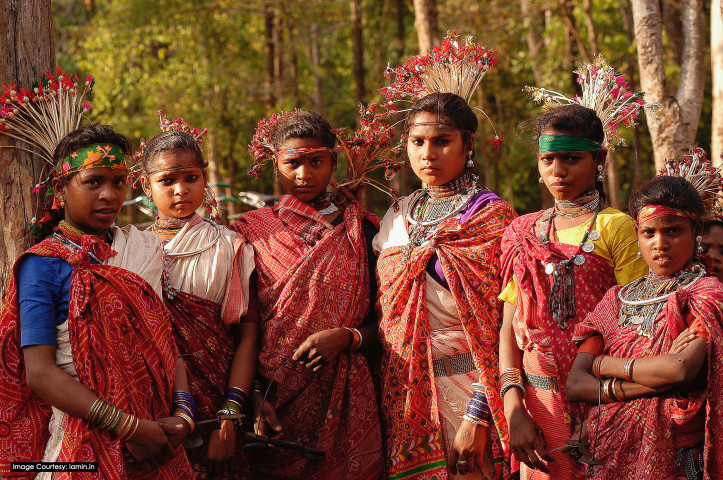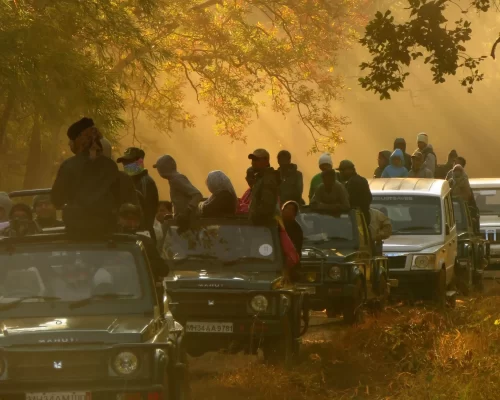India is a land that proudly embraces communities and tribes of diverse origins. It is a land that people from diverse cultures have coexisted in harmony with each other. One such community of people with a Dravidian base that has peacefully existed in the heart of the Indian motherland are the Gondi people. The Gond community is native to the Middle/Central part of India, dating its origin back to the pre-Aryan times. The region that they inhabited was known as Gondwana, meaning Land of the Gond.

Centuries ago, the Gond tribes were ruled by the mighty Gond Kings. They were quite powerful and their kingdom spread across all of Central India till their rule ended in the 16th century. Some sources say that the rule of the Gond Kings ended in the 14th century when Alauddin Khilji defeated all the kings in the Deccan region. Till the fall of the Gond Kings, this tribe was considered one of the largest and most powerful tribes in South Asia, with a rule that lasted 500 years.
The word Gond comes from the Dravidian word ‘Kond’ which translates to ‘Green Mountains’. A term rightly depicting the green mountains the Gond community inhabited of the Godavari gorges in the south to the Vindhya Mountains in the north.
Gonds can be classified into:
- Raj-Gonds
- Khatola-Gonds
- Madia Gonds
- Dhur Gonds
- Dadve Gonds
- Mokasi Gonds
- Gaita Gonds
- Koyas
All members of the Gond community are highly skilled in arts and crafts. Their most famous artwork that belongs to their community is the ‘Gond painting’. Through their paintings, the Gond community passes on their stories and beliefs to the next generation. That is why the Gond artwork depicts the folk tales, religious stories, and their gratitude for nature in the form of wall paintings.
Gond paintings originated in the Mesolithic age, where the ancestors of the Gond community members would decorate the cave walls using colors obtained by natural means. Even today, the community members paint their mud and concrete houses using natural color just as their mesolithic ancestors once did. The main reason that members of the Gond community decorate their home walls is because they believe that ‘viewing a good image brings good fortune.’ That is why till today, members of this community paint the walls of their homes during festivals and special occasions.
The modern form of Gond Painting has its origin in a decorative and symbolic art known as Dingha. The Gond community strongly believes that their artworks can help ward off evil and spread positivity all around. The Gond paintings were long forgotten and were brought to light by a renowned painter, J.Swaminathan, in the late 1980s. He discovered Gond paintings on his visit to a village in Madhya Pradesh where he saw a young Jangarh Singh Shyam (one of the most renowned Gond artists who passed away in Japan on a visit to the Mithila Museum) painting and decorating the huts of his community. Jangarh Singh Shyam was a pioneer who took it upon himself to train the next generation of Gond artists by introducing the concept of painting on canvas using modern painting tools. He worked tirelessly to make sure this art form and his community received worldwide recognition.
The Pardhan Gonds are the members of the community that are designated with the responsibility to carry forward the supreme task of translating oral histories and folklore into beautiful paintings. They are also the oral historians and storytellers on a supreme mission of enlightening the minds of their next of kin. The Pardhan Gonds begin the journey of their artwork by choosing a theme for their painting and then start creating that on a canvas. They apply a simple ‘dot and line’ technique to create the entire artwork. The ‘dot and line’ technique is applied by these artists in Gond artworks to show a sense of activity and movement of the motifs in the painting. The beauty of this artwork lies in its intricacy and simplicity. Today, Gond artists use a wide variety of color mediums. Originally natural colors derived from coal, tree sap, red soil, and sem leaves were used.

Image Credits: Gond Samaj Mahasabha
Truly the Gond community is rich in culture, folklore, and heritage. That is why Red Earth, a stunning wilderness resort in Tadoba, works in synchrony with the Gond Community. This resort in Tadoba believes in nurturing and protecting the local crafts and members of the Gond Community. The resort truly appreciates and values the efforts of the members of the Gond community that help shape the resort to be what it is today.
The Red Earth Tadoba resort takes the concept of eco-tourism very seriously with a strong objective of preserving the local communities, flora, and fauna. That is why visitors at this resort can see an ecosystem where the local Gond community beautifully coexists with the wilderness and the urbanism. All the staff employed at the Red Earth Tadoba resort are members of the local Gond community. The Gondi people know Tadoba’s forests and trail better than anyone else. Because for them Tadoba is their home. Their sanctuary.
The Red Earth Tadoba takes strong initiatives to protect and preserve the interests of the Gond community. The Gondi people are not just employees at the resort, but gatekeepers of centuries-old culture. Adorning the walls around the resort in Tadoba are the Gond paintings done by members of the community. These artworks are a representation of their tradition and heritage. Protecting and nurturing this local gem is what makes the Red Earth Tadoba resort so unconventional. Because this resort walks the walk when it comes to preserving local communities and wilderness.
The resort also allows the members of the Gond community to sell their canvas artworks at their Gift Shop on the premise, with a major focus on sustaining the art of the local community and providing for them by funding their education and health benefits.
The Red Earth Tadoba resort has nothing more than gratitude for the local Gond community that has been a part of the heritage of Tadoba. Visit the Red Earth Tadoba and take back a piece of centuries-old culture with you.



